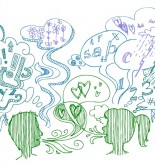Let’s Talk Dialogue
 I was working on a dialogue-heavy scene the other day, which essentially means I spent the day mumbling to myself, constantly asking, would anyone actually say this? For the record, the cat was in the room with me so I wasn’t really talking to myself.
I was working on a dialogue-heavy scene the other day, which essentially means I spent the day mumbling to myself, constantly asking, would anyone actually say this? For the record, the cat was in the room with me so I wasn’t really talking to myself.
But it got me thinking about dialogue, a fundamental writing tool, but one that’s so hard to get right. And if it’s done wrong, can completely ruin a story. While I’m still learning this beautiful craft (and always will be), here are my guidelines for writing dialogue:
Dialogue needs to be realistic, meaning it needs to sound like people actually talk. In real life, we talk informally. We use conjunctions, slang, and merged words (gotta instead of got to, etc.). Our conversations are riddled with ums, uhs, and ers. The key is to keep all this balanced. Not to be so realistic that it detracts from the story. Which is why…
Accents are hard. Personally, I find accents to be jarring and often too heavy-handed. Take Joe in Great Expectations. While I loved him as a character, his phonetic dialogue grated on me. I prefer J.K. Rowling’s approach to accents, especially in The Casual Vacancy. In that novel, Rowling shows just enough of an accent to shed light on a character, but not so much that it pulls the reader out of the story. But what I respect most about Rowling’s use of accents is that it…
Propels the plot forward. All dialogue needs to be integral to the plot. The Casual Vacancy is a commentary on the caste system so it’s important where characters come from and how they speak. Like every sentence, paragraph, and scene, dialogue must have a purpose. If it doesn’t, cut it. A great example of this is in Agatha Christie’s Hercule Poirot novels. So much information is given via dialogue, more than in any other way, but it’s done in a tight fashion. There’s no fluff. Similarly…
Dialogue must be interesting. Think of all the times you’ve been in a conversation and wished you could come up with a witty response or insightful comment? In writing, all this is possible! We can give our characters the gift of gab, great personalities where they’re never at a loss of what to say. Leveraging dialogue this way adds depth to characters. Reagan’s character in Fangirl is a great example. My favorite of her quotes: “But you’re so helpless sometimes. It’s like watching a kitten with its head trapped in a Kleenex box.” This can only be Reagan talking. It’s witty while also giving the reader information about her and her relationship with the protagonist. But again, don’t focus so much on making dialogue interesting that it becomes unrealistic. Speaking of distracting…
Use Dialogue Tags Sparingly. Can the reader tell who’s talking without a dialogue tag? If the answer’s yes, then don’t use one. Some of my favorite scenes to read are snappy ones that are more like a verbal tennis match. If dialogue tags are necessary, I recommend Stephen King’s approach: “To write adverbs is human, to write he said or she said is divine.” No need to dress up the dialogue attributions.
Writers, what are your dialogue dos and don’ts? Readers, what dialogue taboos pull you out of a story?
What I’m reading: Five Little Pigs by Agatha Christie
What I’m listening to? Broken Bells – High Road
Leave a Reply